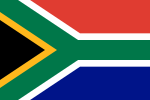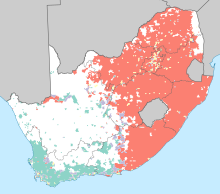
Back Suid-Afrikaanse etniese groepe en kulture Afrikaans الجماعات العرقية في جنوب إفريقيا Arabic Etnias de Sudáfrica Spanish Kelompok etnik di Afrika Selatan ID Grupurile etnice din Africa de Sud Romanian
| Part of a series on the |
| Culture of South Africa |
|---|
 |
| People |
| Cuisine |
| Religion |
| Art |
| Sport |

Racial groups in South Africa have a variety of origins. The racial categories introduced by Apartheid remain ingrained in South African society[1][2][3][4] with South Africans and the governing party of South Africa continuing to classify themselves, and each other, as belonging to one of the four defined race groups (Blacks, Whites, Coloureds and Indians).[4][3] Statistics South Africa asks people to describe themselves in the census in terms of five racial population groups.[5] The 2022 estimates were 81.4% Black or Indigenous South African, 7.3% White South African, 8.2% Coloured South African, and 2.7% Indian South African.[6]: 21
Statistics South Africa provided five racial categories by which people could classify themselves, the last of which, "unspecified/other" drew negligible responses, and these results were omitted.[7] The 2010 midyear estimated figures for the other categories were Black at 78.4%, White at 10.2%, Coloured at 8.8%, Indian/Asian at 2.6%.[8] The first census in South Africa in 1911 showed that Whites made up 22% of the population; it declined to 16% in 1980.[9]
- ^ Rondganger, Lee (6 June 2006). "Being an African makes me who I am". IOL. Retrieved 9 March 2013.
- ^ du Preez, Max (9 March 2011). "Are we all 'coloured'?". News24. Retrieved 9 March 2013.
- ^ a b Posel, Deborah (2001). "What's in a name? Racial categorisations under apartheid and their afterlife" (PDF). Transformation: 50–74. ISSN 0258-7696. Archived from the original (PDF) on 8 November 2006.
- ^ a b Pillay, Kathryn (2019). "Indian Identity in South Africa". The Palgrave Handbook of Ethnicity. pp. 77–92. doi:10.1007/978-981-13-2898-5_9. ISBN 978-981-13-2897-8.
- ^ Lehohla, Pali (5 May 2005). "Debate over race and censuses not peculiar to SA". Business Report. Archived from the original on 14 August 2007. Retrieved 25 August 2013.
Others pointed out that the repeal of the Population Registration Act in 1991 removed any legal basis for specifying 'race'. The Identification Act of 1997 makes no mention of race. On the other hand, the Employment Equity Act speaks of 'designated groups' being 'black people, women and people with disabilities'. The Act defines 'black' as referring to 'Africans, coloureds and Indians'. Apartheid and the racial identification which underpinned it explicitly linked race with differential access to resources and power. If the post-apartheid order was committed to remedying this, race would have to be included in surveys and censuses, so that progress in eradicating the consequences of apartheid could be measured and monitored. This was the reasoning that led to a 'self-identifying' question about 'race' or 'population group' in both the 1996 and 2001 population censuses, and in Statistics SA's household survey programme.
- ^ Census 2011: Census in brief (PDF). Pretoria: Statistics South Africa. 2012. ISBN 9780621413885. Retrieved 21 February 2017.
- ^ Census 2001 Archived 10 August 2007 at the Wayback Machine, Statistics South Africa.
- ^ "Midyear population estimates: 2010" (PDF). Statistics South Africa. Retrieved 23 July 2010.
- ^ South Africa: time running out : the report of the Study Commission on U.S. Policy Toward Southern Africa. University of California Press. 1981. p. 42. ISBN 0-520-04547-5.